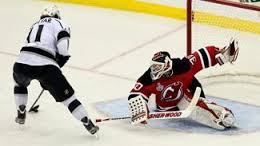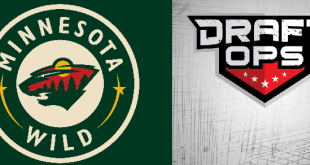Tweet
During the offseason, the NHL announced a number of rule changes that will take effect for the 2014-15 season. While these changes are mainly minor tweaks to current rules, they will have some effect on the play this season and will inevitably cause some unlucky team’s fans frustration after a late loss. With the NHL season starting this week, let’s take a moment to quickly review the most important changes.[i]
Changes to the Ice
The first thing you may notice as you tune into your favorite team’s season opener is that some of the markings on the ice seem a bit different than last year. The NHL has changed Rule 1.8 to expand the trapezoid behind each net by two feet on each side of the net. This effect of this rule change on scoring is unclear. Goaltenders who are good puck handlers will have slightly more room to stop dump-ins and start the breakout for their defenseman, theoretically relieving some of the pressure from opposing fore-checkers. On the other hand, the extra room behind the net could lead to more opportunities for butterfingered goalies to fumble the puck in dangerous areas behind and in front of their nets, leading to easy goals for opposing forwards.
The second change to the ice surface is that the hash marks on the end zone face-off circles have been separated by over 2 ½ feet. While this seems like a minor detail (and it most likely is), this change should provide a bit of extra room for forwards to maneuver after the face-off, increasing the possibility of quick set plays that could lead to additional goals.
More Tripping, Same Number of Penalty Shots?
The NHL has also amended the tripping rule to now prohibit one of the more exciting defensive plays in the game in an attempt to increase scoring. In previous years, where a defensive player stymied an offensive breakaway by contacting an offensive player at the same time as the puck, no penalty would be called – a potentially momentum-turning defensive play. In the case where the defensive player was unsuccessful in accomplishing such a maneuver – contacting the offensive player, before touching the puck, causing him to fall during a breakaway situation – only then would the defensive player would be called for a “trip” and, in cases where his body positioning warranted it, a penalty shot could be awarded.
The new rule now provides that when an attacking player is on a breakaway, a defending player who dives and touches the puck while also contacting and tripping the attacking player will now be called for a 2 minute minor penalty. Previously, this type of play had not been a penalty. While this now punishes a defenses for a previously-legal play, to mitigate the added pressure on the defense, a penalty shot will not be awarded in these types of situations.[ii] As such, officials are instructed to call more penalties for tripping, but the rule change allows them to do so without the paralyzing fear of having to award a game-changing penalty shot.
Though the diving defensive stop that brought fans of defensive hockey to their feet is now a penalty, the rule change could, in theory, have a positive impact on scoring by increasing the odds of an unobstructed breakaway, as well as the number of power plays, while keeping the number of penalty shots constant.
From the Face-off Circle to the Penalty Box
The final rule change of note is the new rule governing face-offs occurring immediately after icing is called. Since the icing rule was amended prior to the 2005-2006 season to prohibit line changes by the defending team during the ensuing stoppage after an icing, teams have countered by having their centers intentionally get tossed from the face-off circle by failing to lineup correctly. Usually, two face-off violations by a center will lead to the center getting tossed from the circle and a winger taking his spot. The extra 30-60 seconds of rest for the defenders while the center stalls at the face-off dot can help tired skaters recover enough to clear the puck and make it to the bench for a line change. This year, the NHL has decided to cut down on these stalling tactics by calling a 2-minute bench minor penalty after a defending player taking the face-off commits a second face-off violation.[iii] Since a two-minute penalty isn’t worth the additional few seconds of rest, teams are likely to abandon this stalling tactic, and a few more tired defenders are going to watch a goal go in right after a face-off following an icing.
Conclusion
The rules discussed above should provide a slight boost to scoring, as well as the requisite anguish of losing fans that learn about a new rule only once it costs their favorite team a vital two points. With a better understanding of the rule changes, sit back and enjoy the start of the new season with all the highlight-reel goals, bone-crushing hits, and mystifying saves that will keep us enthralled for the next eight months.
[i] All of the rule changes for the 2014-15 season can be found here: http://www.nhl.com/ice/news.htm?id=730165. In addition to the rules changes discussed herein, there are also some changes to the overtime rules, the punishments governing diving, and how certain game misconducts will be counted towards a possible one-game suspension.
[ii] A penalty shot may still be awarded, where the body positioning of the players warrants it, in the situation where the defensive player knocks down the offensive player before touching the puck – as was the case under the previous rule.
[iii] Only a warning is issued after the first face-off violation. The second violation actually results in the penalty.
 The Sports Esquires Putting Sports on Trial
The Sports Esquires Putting Sports on Trial



